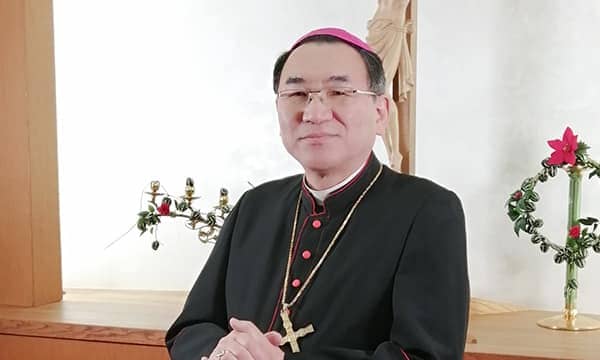ÉVRON, France – In 1992, when Pope John Paul II released his apostolic exhortation Pastores Dabo Vobis (“I will give you shepherds”), the Catholic priesthood was in serious decline. Seminary formation was in disarray, clergy were renouncing their vows, and new vocations were dwindling around the globe.
To address this crisis, John Paul outlined four major dimensions to aid in priestly formation: The human, intellectual, spiritual, and pastoral. The aim of the exhortation was “not only to discern but also to ‘accompany’ priestly vocations.” Central to this was an elevation of the human dimension of the priesthood, which, according to the exhortation, is the “basis of all priestly formation.”
In some respects, this insight had already been realized by Monsignor Jean-Francois Guérin, a French priest who founded the Community of Saint Martin in 1976. For Guérin, the spirituality of the Community was an embrace of the renewal of the Second Vatican Council with a particular focus on the human development of its priests.
Originally founded in the diocese of Genoa, Italy, at the invitation of Cardinal Giuseppe Siri, the Community was born in a poor environment in a former Capuchin monastery. The humble setting formed the DNA of the community, with the Eucharist at the center and a commitment to Church unity as a direct response to what Guérin believed to be the “crisis in identity of priests.”
By 1979, the Community had its first ordinations and over the next decade another twenty followed. In 1993, the Community returned home to its French roots and opened its seminary in Candé-sur-Beuvron, France.
Today its motherhouse is in Évron, France, where they relocated in 2014 after outgrowing their previous home due to an unprecedented uptick in new seminarians. Now under the leadership of Don Paul Préaux, the Community boasts an enrollment of 100 new seminarians and 100 priests serving in dioceses in France, Italy, and Cuba and is one of the fastest growing religious communities in France.
Inspired by Saint Martin of Tours, the spirituality of the order is based on four aspects of the life of the fourth century saint. First, he was a hermit who understood the contemplative life and what can be gained from withdrawing from the world. Second, he founded a monastery, which is viewed as his recognition of the importance of community life.
Third, he was a pastor and a bishop who went out to the peripheries of his time and became the first to found parishes outside of cities. Finally, his constant devotion to the poor set an example of both spiritual and physical poverty, which the Community still tries to model.
According to Préaux, “Saint Martin gave us in the fourth century a model of what priests should be in the 21st century.” In an interview with Crux, Préaux couldn’t help but to offer parallels between the spirituality of the Community and the vision of the priesthood offered by Pope Francis. “We’re trying to live the reality that Pope Francis asks of us, particularly a focus on the poor and the joy of the Gospel. We still see it as a call to conversion for us.”
In its early days many of the bishops in France viewed the Community with “an unfavorable eye,” noted Préaux. Today, however, the Community is represented in 20 dioceses and 35 other French bishops have asked for the Community to send priests their way, placing the Community in direct contact with 55 out of the 100 bishops in the country.
Rather than having specific assignment for its priests, the Community entrusts its members to bishops for a wide range of services, including work in retirement homes, boarding schools, and parish service.
The priests and deacons of the Community live and work in communities of at least three, but with an integrated approach that combines religious life with intentional interaction with lay men and women.
Évron Abbey, which is located two hours southwest of Paris, traces its roots back to the 7th century when it was previously a Benedictine Abbey and then later the home of the Sisters of Charity in Évron. With plenty of room for growth and an attractive bucolic setting, the Community is aiming for greater expansion in Europe and beyond.
Préaux who has been head of the Community since 2010 and was just re-elected for another six-year assignment, has made future growth a key area of discernment for his next term. He anticipates immediate expansion into German speaking countries and has also been in contact with several dioceses in the United States.
In June of this year, another three priests were ordained to the community. Xandro Pachta-Reyhofen entered the seminary in 2010 and the Austria native was the first non-French native to enter the community. Just two weeks before his ordination, he reflected back on what for him was the most unlikely of vocations whose life was changed after meeting a priest from the Community while studying philosophy in Paris.
“The most important thing is to see priests whose priesthood does not diminish their human fulfillment,” Pachta-Reyhofen told Crux. “Clear identity makes the priesthood attractive. You have to be able to imagine yourself in the role of the priest and in the role that is being modeled for you. These were men that I could also see having very successful careers as businessmen, lawyers, or doctors, but were also attracted to the priesthood.”
With a motto of “Taking God seriously, not yourself,” the Community of Saint Martin is aiming to breath new life into the Church through traditional ways. In terms of its own liturgy, formation, and structures, the Community is undeniably rooted in established traditions. But in its daily ministry, it’s unquestionably focused outward on the modern world.
In considering the role of religious life in the 21st century, Préaux isn’t worried about being written off as outdated or irrelevant. “Rather than complaining about a society that isn’t open to us or doesn’t like us, we’re called to encounter them and offer them a real vision of who we are. That work is up to us,” he told Crux.
“If a priest has the smell of the sheep, like Francis tells us we should, it’s because he carried them as well. Not just in liturgical celebrations, but in their daily lives — knowing their needs and their sorrows too.”
















